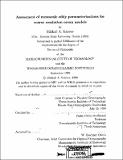Assessment of mesoscale eddy parameterizations for coarse resolution ocean models
Author(s)
Solovev, Mikhail A
DownloadFull printable version (18.08Mb)
Other Contributors
Woods Hole Oceanographic Institution.
Advisor
Paola Malanotte-Rizzoli.
Terms of use
Metadata
Show full item recordAbstract
Climate simulation with numerical oceanic models requires a proper parameterization scheme in order to represent the effects of unresolved mesoscale eddies. Even though a munber of schemes have been proposed and some have led to improvements in the simulation of the bulk climatological properties, the success of the parameterizations in representing the mesoscale eddies has not been investigated in detail. This thesis examines the role of eddies in a 105-years long basin scale eddy resolving simulation with the MIT General Circulation Model (GCM) forced by idealized wind stress and relaxation to prescribed meridional temperature; this thesis also evaluates the Fickian diffusive, the diabatic Green-Stone (GS) and the quasi-adiabatic Gent-McWilliams (GM) parameterizations in a diagnostic study and a series of coarse resolution experiments with the same model in the same configuration. The mesoscale eddies in the reference experiment provide a significant contribution to the thermal balance in limited areas of the domain associated with the upper 1000M of the boundary regions. Specifically designed diagnostic tests of the schemes show that the horizontal and vertical components of the parameterized flux are not simultaneously downgradient to the eddy heat flux. The transfer vectors are more closely aligned with the isopycnal surfaces for deeper layers, thus demonstrating the adiabatic nature of the eddy heat flux for deeper layers. The magnitude of the coefficients is estimated to be consistent with traditionally used values. However, the transfer of heat associated with timedependent motions is identified as a complicated process that cannot be fully explained with any of the local parameterization schemes considered. The eddy parameterization schemes are implemented in the coarse resolution configuration with the same model. A series of experiments exploring the schemes' parameter space demonstrate that Fickian diffusion has the least skill in the climatological simulations because it overestimates the temperature of the deep ocean and underestimates the total heat transport. The GS and GM schemes perform better in the simulation of the bulk climatological properties of the reference solution, although the GM scheme in particular produces an ocean that is consistently colder than the reference state. Comparison of the eddy heat flux divergence with the parameterized divergences for typical parameter values demonstrates that the success of the schemes in the climatological simulation is not related to the representation of the eddy heat flux but to the representation of the overall internal mixing processes.
Description
Thesis (Ph. D.)--Joint Program in Physical Oceanography (Massachusetts Institute of Technology, Dept. of Earth, Atmospheric, and Planetary Sciences; and the Woods Hole Oceanographic Institution), 1999. Includes bibliographical references (p. 248-253).
Date issued
1999Department
Joint Program in Physical Oceanography; Woods Hole Oceanographic Institution; Massachusetts Institute of Technology. Department of Earth, Atmospheric, and Planetary SciencesPublisher
Massachusetts Institute of Technology
Keywords
Joint Program in Physical Oceanography., Earth, Atmospheric, and Planetary Sciences., Woods Hole Oceanographic Institution.